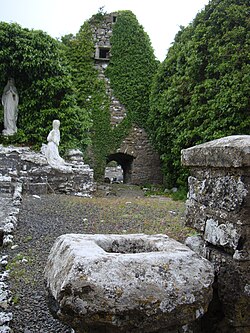Mayo
| Mayo Irish: Maigh Eó | |
| County Mayo | |
|---|---|
 Remains of Mayo abbey church | |
| Location | |
| Grid reference: | M263783 |
| Location: | 53°45’0"N, 9°7’0"W |
| Data | |
| Population: | 426 (2002) |
| Local Government | |
Mayo is a tiny village in County Mayo. Although small today, it has given its name to the county, the county town of which is not here but Castlebar ten miles to the north. Claremorris is six miles to the south-east.
This was the site of an abbey famous in ancient times, and indeed the village is sometimes known as Mayo Abbey. The name is from the Irish language in which today it is rendered Maigh Eo, meaning "Plain of the yew trees". The name is first recorded in English by Bede in the eighth century, as Mag eo and Muigeo, making it one of the oldest Irish place-names recorded in English, and indeed one of the few recorded at all in old English.
History
The village was an important centre in the Gaelic and Anglo-Saxon Christian world in the seventh and eighth centuries. St Colmán, Bishop of Lindisfarne, founded a monastery here for a group of Saxon monks, St Gerald becoming the first abbot in 670.
The Venerable Bede in The Ecclesiastical History of the English People tells of the origin of Mayo in a joint English-Irish monastery established by Bishop Colman on Inishbofin, County Mayo:
'He then moved on to a small island which lies sheltered off the west coast of Ireland and is called in Irish Inisboufinde, that is, the island of the white calf. Arriving there he built a monastery and he placed in it the monks he had brought from both nations. But they could not live in harmony, because the Irish left the monastery in the summer, when the harvest should have been gathered in, and travelled to the different places they knew, and then wanted to make common use of the things the English had prepared. Colman looked for a solution to this strife, and travelling far and wide he found a place in the island of Ireland which was suitable for building a monastery, called in Irish Mag eo; he bought a modest part of it for the building of a monastery from a count in whose possession it was, with the condition that the monks who stayed there should offer prayers for him who had made room for them. A monastery was built straight away with the help of the count and all the neighbours, and Colman put the English there, leaving the Irish on the island we have mentioned. This monastery has English inhabitants to this day. It remains the same, though it has grown large from its small beginnings, and is called Muigeo; it has now adopted a better rule and contains a notable host of monks gathered there from the province of the English. They live following the example of the venerable fathers under a canonical rule with an abbot, in abstinence and truth, by the work of their own hands.'
Danish raiders attacked the monastery in 783 and again in 805.[1] Finally Turgesius completely destroyed it in 818.[1]
The village was the centre of the Diocese of Mayo from 1152 until the diocese was merged with the Diocese of Tuam in the thirteenth century. The diocese was revived later but merged with Tuam once more in 1559 after the Reformation, though Rome continued to appoint its own bishops for Mayo until 1631.
Culture
The BBC four-part documentary Amongst Women was filmed in Mayo Abbey using the Old Catholic Church, the graveyard and the post office/shop.
Sport
- Gaelic football: Mayo Gaels
Annalistic references
- 726 - Gerald, of Magh Eo, died on the 13th of March.
- 726 - Muireadhach, son of Indreachtach, was slain; he was Bishop of Magh Eo.
- 905 - The oratory of Magh-eo was burned.
- M1209.1. Kele O'Duffy, Bishop of Mayo of the Saxons ... died.
- M1478.1. The Bishop O'Higgin, i.e. Bishop of Mayo-na-Saxon, died.